Related Research Articles
The following outline provides an overview of and topical guide to entertainment and the entertainment industry:
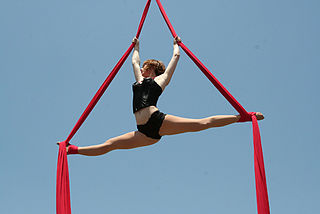
Acrobatics is the performance of human feats of balance, agility, and motor coordination. Acrobatic skills are used in performing arts, sporting events, and martial arts. Extensive use of acrobatic skills are most often performed in acro dance, circus, gymnastics, and freerunning and to a lesser extent in other athletic activities including ballet, slacklining and diving. Although acrobatics is most commonly associated with human body performance, the term is used to describe other types of performance, such as aerobatics.

A trapeze is a short horizontal bar hung by ropes or metal straps from a ceiling support. It is an aerial apparatus commonly found in circus performances. Trapeze acts may be static, spinning, swinging or flying, and may be performed solo, double, triple or as a group act.
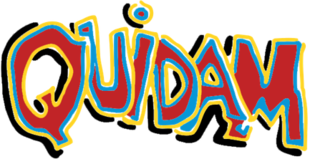
Quidam was the ninth stage show produced by Cirque du Soleil. It premiered in April 1996 and has been watched by millions of spectators around the world. Quidam originated as a big-top show in Montreal and was converted into an arena format beginning with its 2010 tour in North America. It then changed back to the Big Top for a 3-month run in Seoul, South Korea before returning to an arena show for its tour to Oceania. The show performed for the final time in Christchurch, New Zealand on February 26, 2016.
Saltimbanco was a touring show by Cirque du Soleil. Saltimbanco ran from 1992 to 2006 in its original form, performed under a large circus tent called the Grand Chapiteau; its last performance in that form was in Rio de Janeiro, Brazil, on December 10, 2006. A new adaptation of the show started touring North America on July 31, 2007, with its first stop in London, Ontario, Canada. The new version was staged in arenas with fewer performances in each city it visited. The new version closed at the end of 2012.

Alegría is a Cirque du Soleil touring production, created in 1994 by director Franco Dragone and director of creation Gilles Ste-Croix. It takes its name from the Spanish word for "joy".
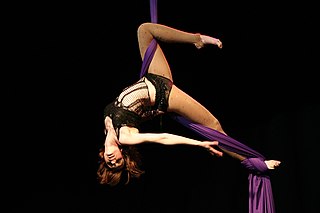
Aerial silks is a type of performance in which one or more artists perform aerial acrobatics while hanging from a specialist fabric. The fabric may be hung as two pieces, or a single piece, folded to make a loop, classified as hammock silks. Performers climb the suspended fabric without the use of safety lines and rely only on their training and skill to ensure safety. They use the fabric to wrap, suspend, drop, swing, and spiral their bodies into and out of various positions. The fabric may also be used to fly through the air, striking poses and figures. Some performers use rosin on their hands and feet to increase the friction and grip on the fabric. Aerial silks is a demanding art and requires a high degree of strength, power, flexibility, courage, stamina, and grace to practice.

The aerial hoop is a circular steel apparatus suspended from the ceiling, on which circus artists may perform aerial acrobatics. It can be used static, spinning, or swinging. Tricks that can be performed include the Candlestick, Bird's Nest and Crescent Moon

Nouvelle Expérience was Cirque du Soleil's fourth touring circus show, which premiered in 1990.

Circus Center is a circus school in San Francisco, California. It was founded in 1984 by Wendy Parkman and Judy Finelli as the San Francisco School of Circus Arts.
Object manipulation is a form of dexterity play or performance in which one or more people physically interact with one or more objects. Many object manipulation skills are recognised circus skills. Other object manipulation skills are linked to sport, magic, and everyday objects or practices. Many object manipulation skills use special props made for that purpose: examples include the varied circus props such as balls, clubs, hoops, rings, poi, staff, and devil sticks; magic props such as cards and coins; sports equipment such as nunchaku and footballs. Many other objects can also be used for manipulation skills. Object manipulation with ordinary items may be considered to be object manipulation when the object is used in an unusually stylised or skilful way or for a physical interaction outside of its socially acknowledged context or differently from its original purpose.

Zaia was a Cirque du Soleil stage production based at The Venetian Macao on the Cotai Strip in Macau. The 90-minute show opened in August 2008, bringing together 75 high-calibre artists from around the world. Zaia was Cirque du Soleil's first resident show in Asia and was directed by Neilson Vignola and Gilles Maheu. The custom-built theater housing the performance was capable of seating 1,800 spectators at a time.
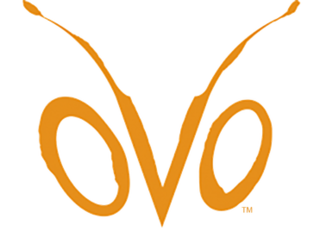
Ovo is a touring circus production by Cirque du Soleil that premiered in Montréal, Canada in 2009. Ovo's creator and director, Deborah Colker, took inspiration from the world of insects. The idea for Ovo was not to be about the acts, nor dancing, nor insects, but about movement. The movement of life permeates the entire show, with creatures flying, leaping, bounding, and crawling. Composer Berna Ceppas brought additional life to Ovo with a score inspired by the music of Brazil. Ovo means "egg" in Portuguese and represents the underlying thread of the show. Graphically, inside the logo of Ovo, is an insect. The two O's represent the eyes and the V forms the nose and antennas.
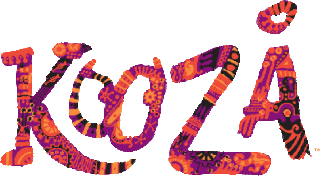
Koozå is a touring circus production by Cirque du Soleil which premiered in Montréal, Quebec, Canada, in 2007. The show was written and directed by David Shiner, who had previously worked as a clown in Cirque du Soleil's production of Nouvelle Expérience. His experience as a clown and his time with Switzerland's Circus Knie and Germany's Circus Roncalli informed his work on Koozå.
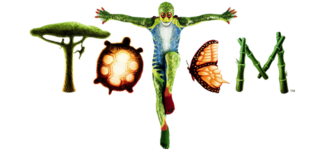
Totem is a touring show by Cirque du Soleil that premiered in Montréal on April 22, 2010. It was written and directed by previous collaborator Robert Lepage (Kà). Cirque du Soleil describes Totem's theme as the evolution of humanity from its primordial, amphibian state toward the aspiration of flight, taking inspiration from many of humanity's founding myths. The show was awarded the 2013 New York Drama Desk Award for Unique Theatrical Experience.

Zarkana was a Cirque du Soleil stage production written and directed by François Girard. It began as a touring show in 2011 and was converted to a resident show in Las Vegas in late 2012. It premiered at Radio City Music Hall in New York City on June 29, 2011, and later toured to the State Kremlin Palace in Moscow and the Madrid Arena in Madrid.
Aerial Manx. is an Amsterdam-based Australian sideshow entertainer who has pioneered the field of acrobatic sword swallowing. Aerial Manx was born on 18 March 1986 in Melbourne, Australia.

Joyà is an 80-minute long resident show at the Vidanta resort in the Riviera Maya, Mexico, produced as a collaboration between Cirque du Soleil and its subsidiary Cirque du Soleil Events + Experiences. It is Cirque du Soleil's first resident show in Latin America.
References
- ↑ "The Classification of Circus Techniques" by Hovey Burgess. The Drama Review: TDR, Vol. 18, No. 1, Popular Entertainments (Mar., 1974), pp. 65-70. doi:10.2307/1144863.
- ↑ "Aerial Acts". Flying High Circus, Florida State University. Archived from the original on 31 December 2009. Retrieved 13 November 2012.